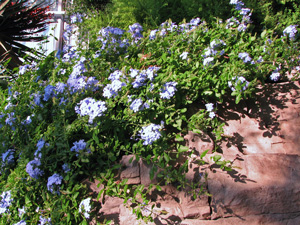Resource Library
Plant of the Week: Plumbago (Leadwort)
The University of Arkansas System Division of Agriculture does not promote, support or recommend plants featured in "Plant of the Week." Please consult your local Extension office for plants suitable for your region.
Plant of the Week
Plumbago or Leadwort
Latin: Ceratostigma plumbaginoides

Keeping the ground covered with vegetation is an indisputably good thing, but we all know plants come and go either disappearing for their season or rest or, too often, to the great hereafter of the plant world. In sunny locations, grasses – especially tough ones such as bermudagrass – become the default groundcover but, with a little attention to detail other groundcovers can be used. Plumbago (Ceratostigma plumbaginoides) is one to consider.
Plumbago, or leadwort as it is often called, is a rhizomatous mat-forming perennial from the Beijing region of China that belongs to the plumbago family. It has a woody crown and herbaceous stems. In areas with winter temperatures below 15 degrees Fahrenheit, the stems freeze back and new, erect stems emerge from the rhizomes in late spring or even early summer. Plants grow 6 to 10 inches tall and will spread as wide as conditions permit. Though the plant does spread I’ve found it to be a tentative spreader that never has come close to being problematic by taking over neighboring plants.
Oval, shiny green, spirally arranged leaves to 2 inches long turn maroon in the fall and present an effective display. In late summer and throughout the fall in a protracted blooming season five petaled, three quarter inch gentian blue flowers are produced at the ends of stems and create a good late season display. The effect is similar to that of the spring flowering woodland phlox (Phlox divaricata).
Plumbago was probably first described to the Western garden world in 1819 when Clarke Abel (the English gardener for whom Abelia is named) saw the plant growing in pots in the Imperial Court in Beijing. However, its collection and description fell to the Russian botanist Alexander von Bunge who collected and described the plant in 1833.
The common name plumbago comes from a Latin word meaning “looks like lead.” The derivation of this common name is uncertain though it is used by both Pliny the Elder (23–79 AD) and Dioscorides (40-90 AD). The name has variously thought to have been derived from the ability of the plant to cure lead poisoning, from the resemblance of the flowers to the color of lead, and to the fact that a lead staining plant dye could be made from the plant. The Latin name is from the horn-like appearance of the stigma.
Leadwort is hardy from zone 5 through 9 though in northern areas a wintertime mulch is recommended. It makes a good addition to the rock garden or as a groundcover on sloping sites that must fend for themselves. Don’t plant it in a situation where it is forced to compete with vigorous grasses such as bermudagrass, for it will lose the contest. It grows in well-drained, sunny- to medium-shade sites where it will tolerate considerable drought. It grows in most average soils though does seem to have an aversion to high clay content soils. Even in mild areas the foliage is often tattered and weather-worn but the plants come through the winter in better condition if the stems are not trimmed back until the worst part of winter has passed.
By: Gerald Klingaman, retired
Retired Extension Horticulturist - Ornamentals
Extension News - November 9, 2012
The University of Arkansas System Division of Agriculture does not maintain lists of retail outlets where these plants can be purchased. Please check your local nursery or other retail outlets to ask about the availability of these plants for your growing area.